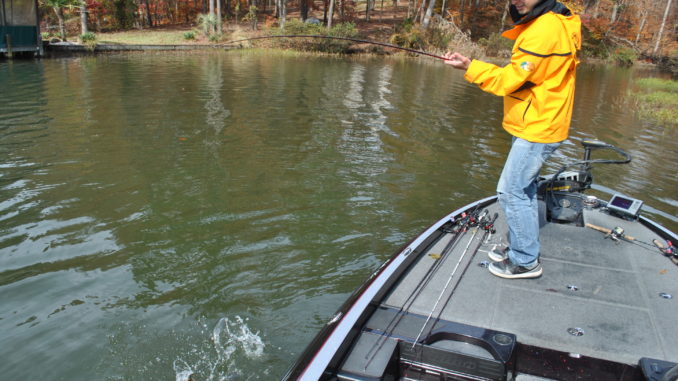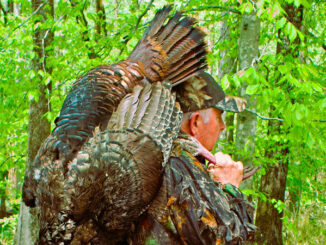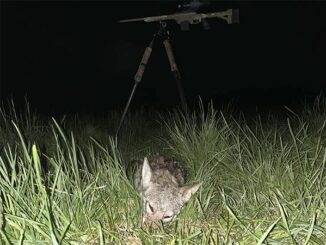
A lot of fishermen approach February as a good month to go to boat shows and look at all the newest boats and fishing tackle, but some years, you miss out on a lot of good fishing by staying off the lake.
Bass fishing can be good in February if you’ve got clear water. You need to be selective in where you fish; stick to lakes with clear water like Wylie, Norman and Badin, and in South Carolina, Murray and Hartwell. Cold, dirty water will kill your fishing trip before you even crank your outboard. Bass are more active in clear water when it’s cold; if you’re fishing a lake with water of a lot of different clarities, stick with the clear water.
One thing to know about winter bass: they like to feed looking up. Baits like a Berkley Bad Shad — a swimming crankbait — a jerkbait, slow-rolling a spinnerbait, even fishing a little swimsuit, will be good because you can fish them in open water, off the bottom, and fish that are looking up for the schools of shad — because that’s where they spend the winter — they’ll see those baits. You want to fish a bait with a small profile, a skinny bait like a jerkbait or a Bad Shad. A bass that’s in 20 feet of water will come up to hit a Bad Shad or a bait like that. You are not fishing on the bottom, because most of the fish aren’t on the bottom; they’re up off the bottom, under the shad.
One thing you have to do with any baits is to fish them slowly. One of the best ways to fish a bait like a Bad Shad is to cast it out, crank it down, then retrieve it by pulling the bait along with your rod tip, then winding up the slack, pulling the bait with your rod tip, winding up the slack. That is probably the best retrieve for a swimming crankbait, because the bait suspends after you finish pulling it, and by winding up the slack, you’re ready if a fish comes up and grabs it. If you’re fishing a jerkbait like a Berkley Cutter, you want to wind it down about 5, 6 or 7 feet, then just pause and let it sit. Normally, you’d only let it sit a second or two before jerking it, but in February, you might let it sit five or 10 seconds. Jerk it a few times and let it sit again. If you’re fishing a spinnerbait, just slow-roll it down. If you’re fishing a little swimbait, let it sink, lift it up and wind in the slack, let it sink again, lift it again. More tournaments are won this time of year by fishing baits this way than any other way.
Now, a lot of fishermen will get hung up on fishing jigs this time of year, but if you do, you’re fishing the bottom, and you’re not going to have your bait around enough fish. Yeah, you might catch a big one, but you’ll put your bait in front of far more fish if you’re fishing it in open water, over their heads.
Where to find them
Here’s where I’m looking to fish in February. After finding some clear water, I’m going to be fishing shallow next to deep water, or right off a break so the bait is sitting over deep water. A No. 7 Bad Shad will dive about 8 feet, and fish will come up a long way to get it. On warm days, fish will sometimes move up into deep pockets. Look for pockets that are protected from that cold, north wind. And don’t worry about trying to establish a pattern. Bass don’t pattern very well in February; they are where they are.
Tackle the problem
It’s sometimes tough to really cast little baits like a Bad Shad or a small jerkbait on baitcasting tackle. Lots of guys fish spinning tackle, but a cranking rod with a good, slow action will do the trick. I fish these February baits on a 6-foot-8, Lew’s David Fritts cranking rod with a Lew’s BB1 reel with a slow, 5-to-1 gear ratio. That will help you keep your retrieve slow; it’s hard to wind a bait too fast with a reel that slow.
A huge factor is the line you use. You should never use anything heavier than 10-pound test. Heavy line can inhibit a small bait’s action. I think you should try and use 8-pound test any time you can get away with it. Baits become a lot more lively on 8-pound test, and since you’re fishing in open water, you’re not likely to get hung up on anything that might break your line. You just have to manage your fish once you hook him. Being able to fish 8-pound test line is a huge advantage.
As far as colors, you need just a handful for late-winter fishing. Think shad patterns, chrome, gold and crawfish. You need to have one of those colors tied on.
Fluoro’s fine:
Fluorocarbon fishing line isn’t normally associated with fishing crankbaits or jerkbaits because the weight of the line takes away a little bit of a bait’s action, but in February, it’s a great line option, according to David Fritts. “I’m not a big fluorocarbon guy, but in the winter, you can get a bait to suspended better if you’re fishing fluorocarbon, especially a jerkbait,” he said. “I fish Trilene 100 Percent Fluorocarbon. It’s a great line.”





Be the first to comment